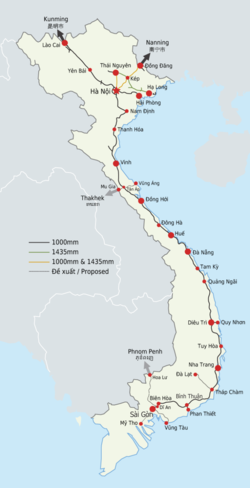| Rail transport in Vietnam | |||||
|---|---|---|---|---|---|
| Operation | |||||
| National railway | Vietnam Railways | ||||
| System length | |||||
| Total | 2,600 kilometres (1,600 mi) | ||||
| Double track | 0 km (0 mi) | ||||
| Electrified | 0 km (0 mi) | ||||
| High-speed | 0 km (0 mi) | ||||
| Track gauge | |||||
| Main | 1,000 mm (3 ft 3+3⁄8 in) 1,435 mm (4 ft 8+1⁄2 in) | ||||
| Meter gauge | 2,169 km (1,348 mi) | ||||
| Standard gauge | 178 km (111 mi) | ||||
| Features | |||||
| No. tunnels | 39 | ||||
| Tunnel length | 11,512 m (37,769 ft) | ||||
| No. bridges | 1,790 | ||||
| No. stations | 278 | ||||
| |||||
The railway system in Vietnam is owned and operated by the state-owned Vietnam Railways (Vietnamese: Đường sắt Việt Nam). The principal route, the single track North-South Railway running between Hanoi and Ho Chi Minh City, accounts for 1,726 kilometres (1,072 mi) of the network's total length of 2,600 kilometres (1,600 mi). The national railway network uses mainly metre gauge, although there are several standard gauge and mixed gauge lines in the north of the country.[1][2]
The first railways in Vietnam were established in the 1880s, with construction beginning in 1888; these included a tram running between the ports of Saigon and Cholon, and a regional rail line connecting Saigon with Mỹ Tho. Railway construction flourished soon afterwards, during the administration of Paul Doumer as Governor-General of French Indochina from 1897 to 1902. It was during this time that construction of the Yunnan–Vietnam and North–South railways began. Construction of the north–south line took over thirty years, finally ending in 1936, during which time other branch lines were also completed. Beginning in World War II, the entire rail network became a target of bombing attacks by a number of groups, including both North Vietnamese and South Vietnamese troops during the Vietnam War. Although the main lines—particularly the North–South line—were quickly restored and returned to service once conflict ended, many branch lines were abandoned and dismantled at their expense, their infrastructure used to replace damaged sections of the main lines, or sold as scrap.[1][3]
With increased economic growth brought on by the Doi Moi reforms of the late 1980s, the railway system has entered a renewed phase of development. A number of major projects supported by official development assistance have been proposed or are currently underway, including a series of projects to improve bridge and railway safety on the North-South Railway line,[3] connections to Cambodia and Laos,[4] and the restoration of a number of defunct lines, including the Đà Lạt–Tháp Chàm railway first established in the 1930s. A high-speed rail link between Hanoi and Ho Chi Minh City has also been proposed, which would reduce journey length from 30 hours to around 6 hours.[1][5] Laos has held a ceremony but construction remains stalled (2019) on a rail line to Lao Bao from Savannakhet, across from the Thai rail head to Bangkok. Two project for high-speed railway include the North-South Railway Express and the Ho Chi Minh City–Cần Thơ express railway.
- ^ a b c Cite error: The named reference
adb-laocaiwas invoked but never defined (see the help page). - ^ Cite error: The named reference
vr-infrawas invoked but never defined (see the help page). - ^ a b Cite error: The named reference
jica-bridgerehabwas invoked but never defined (see the help page). - ^ Cite error: The named reference
aseansec-skrlwas invoked but never defined (see the help page). - ^ Cite error: The named reference
afp-jun2010-highspeedwas invoked but never defined (see the help page).
